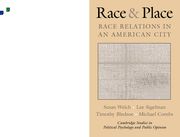Book contents
- Frontmatter
- Contents
- List of Figures
- List of Tables
- Preface
- 1 Introduction
- 2 Race Relations in Detroit, 1968–1992
- 3 Black–White Social Interaction
- 4 Perceptions of Racial Discrimination
- 5 Black Racial Solidarity
- 6 White Racial Prejudice
- 7 Opinions on Urban Issues: The Schools and the Police
- 8 Conclusions
- Appendix A The Detroit Surveys
- Appendix B Detroit Survey Items and Measures
- References
- Author Index
- Subject Index
- Miscellaneous Endmatter
Appendix A - The Detroit Surveys
Published online by Cambridge University Press: 05 June 2012
- Frontmatter
- Contents
- List of Figures
- List of Tables
- Preface
- 1 Introduction
- 2 Race Relations in Detroit, 1968–1992
- 3 Black–White Social Interaction
- 4 Perceptions of Racial Discrimination
- 5 Black Racial Solidarity
- 6 White Racial Prejudice
- 7 Opinions on Urban Issues: The Schools and the Police
- 8 Conclusions
- Appendix A The Detroit Surveys
- Appendix B Detroit Survey Items and Measures
- References
- Author Index
- Subject Index
- Miscellaneous Endmatter
Summary
Between mid-July and mid-November, 1992, representatives of the Center for Urban Studies, Wayne State University, conducted in-home interviews with 1,124 residents of the Detroit metropolitan area. Funding for the survey was provided by National Science Foundation Grant SES-9112799.
Every household in the tricounty area was eligible for inclusion in the sample, but the stratification scheme made use of higher sampling fractions for African Americans, city residents, and residents of mixed-race neighborhoods than for whites, suburbanites, and residents of singlerace neighborhoods. In mixed-race neighborhoods, interviewers engaged in doorstep screening to adjust for the overrepresentation of members of the predominant race (African Americans in the city, whites in the suburbs). In mixed-race neighborhoods in Detroit, interviews were conducted in every white household that was contacted but in only one out of every three black households. In mixed-race neighborhoods in the suburbs, interviews were conducted in every black household that was contacted but in only one out of every four white households. After interviewers established that an interview should be conducted in a given household, they used a “Kish table” to determine who within the household should be interviewed, and made as many as 10 call-backs to contact the designated respondent. In every instance, the race of the interviewer was matched to that of the respondent.
The response rate for the survey was approximately 56%. It was higher for African Americans than for whites and for city residents than for suburbanites.
- Type
- Chapter
- Information
- Race and PlaceRace Relations in an American City, pp. 171 - 172Publisher: Cambridge University PressPrint publication year: 2001



